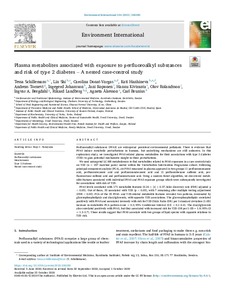Plasma metabolites associated with exposure to perfluoroalkyl substances and risk of type 2 diabetes - A nested case-control study
Brunius Carl; Bergdahl Ingvar A; Kiviranta Hannu; Donat-Vargas Carolina; Schillemans Tessa; Shi Lin; Koponen Jani; Hanhineva Kati; Landberg Rikard; Tornevi Andreas; Åkesson Agneta; Johansson Ingegerd; Rolandsson Olov
Plasma metabolites associated with exposure to perfluoroalkyl substances and risk of type 2 diabetes - A nested case-control study
Brunius Carl
Bergdahl Ingvar A
Kiviranta Hannu
Donat-Vargas Carolina
Schillemans Tessa
Shi Lin
Koponen Jani
Hanhineva Kati
Landberg Rikard
Tornevi Andreas
Åkesson Agneta
Johansson Ingegerd
Rolandsson Olov
PERGAMON-ELSEVIER SCIENCE LTD
Julkaisun pysyvä osoite on:
https://urn.fi/URN:NBN:fi-fe2021042827496
https://urn.fi/URN:NBN:fi-fe2021042827496
Tiivistelmä
Perfluoroalkyl substances (PFAS) are widespread persistent environmental pollutants. There is evidence that PFAS induce metabolic perturbations in humans, but underlying mechanisms are still unknown. In this exploratory study, we investigated PFAS-related plasma metabolites for their associations with type 2 diabetes (T2D) to gain potential mechanistic insight in these perturbations.We used untargeted LC-MS metabolomics to find metabolites related to PFAS exposures in a case-control study on T2D (n = 187 matched pairs) nested within the Vasterbotten Intervention Programme cohort. Following principal component analysis (PCA), six PFAS measured in plasma appeared in two groups: 1) perfluorononanoic acid, perfluorodecanoic acid and perfluoroundecanoic acid and 2) perfluorohexane sulfonic acid, perfluorooctane sulfonic acid and perfluorooctanoic acid. Using a random forest algorithm, we discovered metabolite features associated with individual PFAS and PFAS exposure groups which were subsequently investigated for associations with risk of T2D.PFAS levels correlated with 171 metabolite features (0.16 <= vertical bar r vertical bar <= 0.37, false discovery rate (FDR) adjusted p < 0.05). Out of these, 35 associated with T2D (p < 0.05), with 7 remaining after multiple testing adjustment (FDR < 0.05). PCA of the 35 PFAS- and T2D-related metabolite features revealed two patterns, dominated by glycerophospholipids and diacylglycerols, with opposite T2D associations. The glycerophospholipids correlated positively with PFAS and associated inversely with risk for T2D (Odds Ratio (OR) per 1 standard deviation (1-SD) increase in metabolite PCA pattern score = 0.2; 95% Confidence Interval (CI) = 0.1-0.4). The diacylglycerols also correlated positively with PFAS, but they associated with increased risk for T2D (OR per 1-SD = 1.9; 95% CI = 1.3-2.7). These results suggest that PFAS associate with two groups of lipid species with opposite relations to T2D risk.
Kokoelmat
- Rinnakkaistallenteet [19207]
